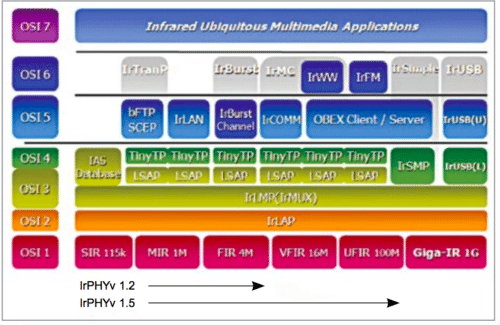Infrared Data Association, or IrDA in short, is a group of device manufacturers that developed a standard for transmitting data via infrared (IR) light waves. It provides specifications for the complete set of protocols for wireless IR communication. The main reason for using IrDA had been wireless data transfer over the “last one meter” using point-and-shoot principles. It is famous for secure data transfer, line-of-sight and very low bit error rate that makes it very efficient [1].
IR communication is an inexpensive and widely adopted short-range (1-3m) wireless technology. It is widely used in consumer electronics, automobiles, computers, medical devices, household appliances, commercial services, etc.
IrDA-enabled devices can communicate and are bi-directional. IrDA is inexpensive, secure and fast (supporting speeds of up to 100Mbps and even more).

The Open Systems Interconnection (OSI) model of IrDA protocol stack is shown in Fig. 1. Some of the specifications based on the OSI model are given below:
Infrared physical layer (IrPHY)
This specification is intended to facilitate point-to-point communication between electronic devices. It specifies the optical media interfaces for Serial Infrared (SIR) data transmission and is part of the first layer of the OSI model.
Infrared link access protocol (IrLAP)
This specification is part of the second layer of IrDA specifications. It lies on top of the IrPHY layer and below the IrLMP layer. It represents the data link layer.
Infrared link management protocol (IrLMP)
It is the third layer of IrDA specifications. It defines link management multiplexer and link management information access service.
Transport protocol (TinyTP)
This optional protocol specified in the fourth layer lies on top of the IrLMP layer.
Infrared communication protocol (IrCOMM)
The IrCOMM protocol specified in the fifth layer lets the infrared device act like either a serial or parallel port.
Infrared Financial Messaging (IrFM)
This protocol specified in the sixth layer is a wireless payment standard developed by the Infrared Data Association.






